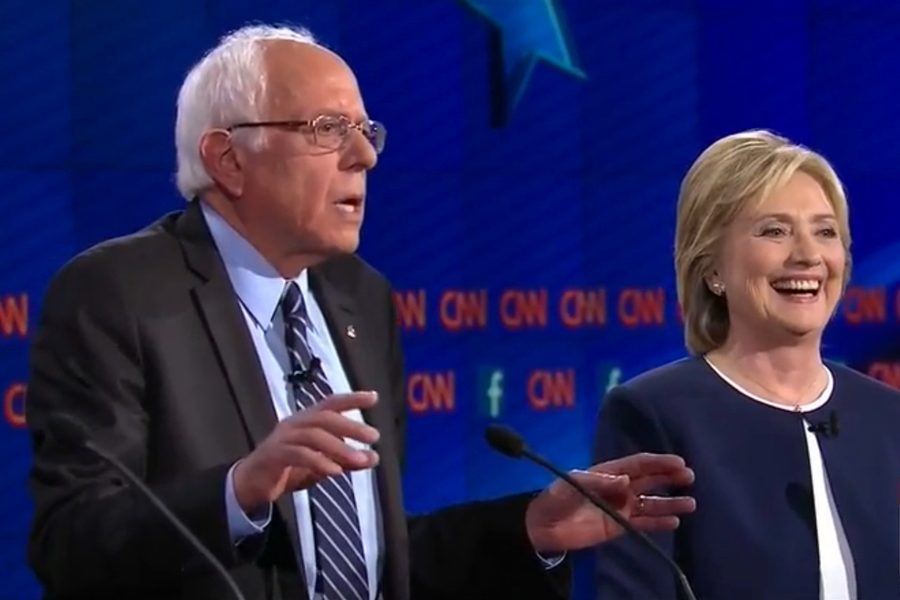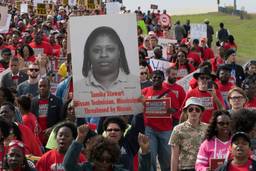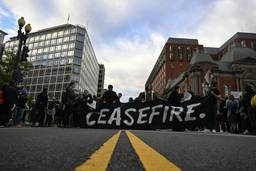
Vermont Sen. Bernie Sanders owes his virtual tie with Hillary Clinton in the Iowa caucus and his win in New Hampshire to his urgent warning about the threat that escalating inequality of incomes and wealth poses to America. Yet despite its power to excite younger voters, it is still unclear whether this message that a billionaire class in this country rigs the economy to its advantage and maintains political power through a corrupt campaign finance system has the legs to take him to victory.
Whatever the strength of the fight against inequality as a campaign focus, a growing body of research underscores the credibility and immediacy of his alarms about the social, economic and political dangers of the widening gap between the richest 1 percent and the rest of the country. It is both a symptom of other deep-seated problems and the cause of many of our most troubling challenges, far beyond even what Sanders says.
For example, growing economic inequality also damages other countries and indeed the whole world, as a recent report released from the British-based NGO, Oxfam, demonstrates. Although Oxfam historically has tried to raise out of poverty the billions of people barely scratching out a means of survival, there is a separate but integrally related fight against inequality of both incomes and wealth that is just as important.
The latest figures on inequality of wealth, derived from a Credit Suisse report, show that the richest 1 percent of the world’s people now have more wealth than the rest of the world combined. Indeed, as Oxfam calculates, the 62 richest individuals have as much wealth as the poorest half of the global population — down from 388 individuals just five years ago (reflecting a greater concentration of wealth at the top). In that short time, the wealth of those 62 rich persons increased by 44 percent to around a half trillion dollars (more precisely, $542 billion) to $1.76 trillion. Meanwhile, the wealth of the poorest 3.6 billion people on the planet dropped by 41 percent more than a trillion dollars.
Oxfam acknowledges the “fantastic progress” made from 1990 to 2010 in reducing by half the numbers of people living in extreme poverty, defined by the World Bank as $1.90 per person per day. That happened during a period when the poor shared very little of global economic growth: since the turn of the century, the poorest half of the population accrued only 1 percent of the increase in global wealth, while the richest 1 percent captured half of the increase. For roughly a quarter of a century, the daily income of the poorest people has increased by less than one penny every year (rising by much more in many Asian countries, especially China, but by the least in Africa). Because so many poor were very close to the cut-off line for extreme poverty in 1990, the world inched across its Millennium Goal on extreme poverty.
Nevertheless, the poorest tenth of the world still faces the greatest threat from global warming, even though the average global warming impact from each member of the richest 1 percent is about 175 times the impact of each of the poorest tenth.
Apologists for the way things are typically argue that little would be accomplished by spreading the wealth of the very rich around, but Oxfam calculates that if only the growth in inequality had remained the same as it was at the start of that quarter century, then 200 million more people would have escaped extreme poverty.
“Growing inequality is bad for us all,” the Oxfam report states, “It undermines growth and social cohesion. Yet the consequences for the world’s poorest people are particularly severe.”
“We can’t blame a few rich people for global poverty,” Peterson Institute for International Economics senior fellow Justin Wolfers wrote last year in The New York Times, in a typical mainstream economics view. “The world’s richest…people hold only a tiny sliver” of global wealth.” But global economics expert Lawrence Chandy and two colleagues argue in a Brookings Institution newsletter that “the global poverty gap is falling. Billionaires could help close it.” Here’s the plan: The richest billionaire in each developing country, where there is at least one such rich individual, would give away half of his wealth each year for 15 years to provide transfer payments to the poor in his home country. Such charity would wipe out poverty in many countries, but only reduce poverty by a few percentage points in many large African countries.
As it is now, the wealthy gain not only material goods and services far beyond the dreams of even the moderately well off, they also gain political power and extraordinary influence in both rich and poor countries, shaping economies and politics to suit their needs.
They can even warp the culture in ways to protect their interests and divide the vast majority into warring factions. In the U.S., the longtime anti-racism campaigner and author, Tim Wise, writes in his new book, Under the Affluence (City Lights Books), the political right succeeds in dehumanizes the “have-nots and have-lessers” while venerating the rich.
In the case of Donald Trump, to take one relevant example, large numbers of Americans with modest incomes see him as their leader against the demonized immigrants and other people different from them, hailing the real estate heir and speculator, whose deals have often failed as a “maker,” not a “taker.” Unlike the first gilded age of the 1890s, when there was widespread empathy for the poor and the beginning of demands for the government to do more to advance social well-being, the rich and political right-wingers have now created “a growing culture of cruelty,” Wise writes.
The extreme concentration that is accelerating in both rich and poor countries threatens the achievements of the more egalitarian rich countries as well as the improvement of life for the global poor. Oxfam highlights the role of the financial sector of the global economy, dominated by firms from rich countries, as one of the driving forces of the new global inequality. The growing power of the financial sector led to its capture of 30 percent or more of all corporate profits in several national economies, including the U.S., before the financial crisis led to the Great Recession. Rampant financial speculation and corruption had destabilized the economy, increased the share of national income to capital as opposed to labor, fostered the growth of extreme corporate officer and financial trader incomes, increased pressure to reduce workers’ income (especially through the trading in corporate control through corporate raids, mergers and divestments), and increased inequality dramatically.
After they have captured greater wealth, the new, more-rich want to protect their swollen assets from taxes that governments might otherwise use to create less cruel, more egalitarian societies. The Oxfam report and a revelatory and rigorous new book—The Hidden Wealth of Nations: The Scourge of Tax Havens (University of Chicago Press) by Gabriel Zucman — focus attention on one mechanism the wealthy use to protect their wealth at the expense of their fellow citizens: tax havens.
The rich now use these secretive business fronts and banks — often located in small countries, such as Switzerland, Ireland, Bermuda or the Cayman Islands — to shelter at least $7.6 trillion, or roughly 8 percent of global household assets, Zucman, an economist at the London School of Economics and Politics, calculates. With help from a growing branch of the financial services sector — the specialists in evading taxes both legally and illegally, these hidden assets have increased by more than 25 percent in just the past five years.
Corporations are busily devising new versions of such evasive strategies, such as tax inversion schemes. (For example, Johnson Controls bought Tyco International in order to set up a legal headquarters in low-tax Ireland so that the company can save $150 million in taxes on $32 billion in sales from the merged company managed primarily from Milwaukee.)
The Oxfam investigation concluded that 9 out of 10 major global companies use at least one tax haven. And the rich in poor countries behave just as contemptuously toward the poor: with one-third of Africa’s wealth in offshore tax havens, African governments lose $14 billion a year, enough to save the lives of 4 million children or put every African child in school, Oxfam concludes.
While “market fundamentalism” — identified by Oxfam as a primary source of the problems — may be used to justify this plundering by the wealthy, the new “casino capitalist” behavior reflects an abuse of power more than any deference to the market. But both the behavior and the reigning ideology exploit the vast majority of the world’s people, undermine the state and its essential functions (through political influence, corruption and deprivation of revenue), and enrich the very few.
When American businesses with tax avoidance accounts in Bermuda report that 3.3 percent of their profits originated in that small country (where their sales were only 0.3 percent of all of the income earned by the firms), as Oxfam reports, they are clearly shifting profits to pay the least tax possible. That option is mainly available to big companies, who gain unfair advantage over smaller, more honest businesses. They also deprive governments of taxes in both their home countries and the poor countries where they offshore much of their business (costing those countries about $100 billion a year, according to Oxfam).
Oxfam insists that it is necessary to end the tax haven schemes, and Zucman has proposed a plan, drawing on a few ideas already utilized by a few countries, that may be able to tackle the problem of tax havens. In his plan, all governments would create a comprehensive register of financial assets held in their nation’s financial institutions or face economic sanctions if they did not cooperate. Then governments would collectively impose a small wealth tax (possibly as low as 0.1 percent) on all of the registered financial assets. In order to recover that wealth tax, the owners would have to declare their holdings and income on tax returns in their legal corporate home country. So they would at least have to pay a global wealth tax or their appropriate home country taxes.
The global casino of financial manipulation and speculation has grown rapidly and contributed mightily to the shift of wealth to the richest. It now accounts for one-fifth of global billionaires. But the rich gain wealth (or rent, that is, income above competitive market returns) through use of monopoly power, political influence (including bribery), and other subterfuges to win public subsidies and escape taxes. Meanwhile, they protect their wealth through expansive — and, for consumers, expensive — intellectual property agreements.
Ultimately, as the Oxfam report and other research shows, inequality not only worsens the material well-being and the social opportunities of the majority of a society, it also reduces economic growth rates. Inequality undermines effective government and democracy, threatens the existence of community spirit and action (or social solidarity), and increases many social as well as physical ailments (from causing both more crime and premature death).
Across most countries, rich or poor, workers have been losing their share of national income in recent years, including gaining little or nothing from productivity growth. The pressures downward on wages come from many sources, including high unemployment, precarious labor arrangements (such as subcontracting, casual labor or temp work), excessive pay and perks for executives, and both lack of unions and governmental failure to protect worker rights — although Oxfam gives neither much emphasis.
Ultimately, most of these forces towards inequality of wealth and income involve some important elements of unequal economic or political power, even if the impact appears to be a result of the play of anonymous market rules and advantages in efficiency. But the Oxfam report gives little attention to the need for any countervailing power to that of capitalists (who are involved through multiple sectors, such as finance or manufacturing) and government officials on behalf of more equity for workers.
Most of the report’s proposals require government action, and Oxfam obviously thinks highly of NGOs and charities that work against poverty and inequality. It barely acknowledges that reversing the growth of inequality is likely to require workers and the poor to mobilize on their own behalf for economic and political power through trade unions, popular movements, political parties and other means, such as the widespread, seemingly spontaneous riots in China that have helped to raise wages there.
Those raises may slow down slightly the surge of Chinese exports to the U.S., especially since China won approval of Permanent Normal Trade Relations with the U.S. and admission to the World Trade Organization in, respectively, 2001 and 2000. China’s rise as an exporter from domestic manufacturers and offshore subcontractor for U.S. firms selling back to the United States grew rapidly. In a recent paper, economist David Autor and two colleagues largely reversed their earlier view that international trade provided a net benefit for the U.S. economy as a whole and also did not do long-term harm to U.S. workers’ wages or employment. The shock from China’s low-wage advantage not only wiped out many U.S. jobs — especially in manufacturing — but also hampered replacement by other industries in the local labor market. The elimination of jobs and loss of buying power also meant that non-manufacturing jobs that did not suffer head-on competition with Chinese products also lost jobs and earnings in local job markets.
The U.S. government in negotiation with China largely created this market for the imported goods, knowing that both Chinese and U.S. firms would use this platform to increase exports. They should have easily realized that the results would increase inequality and reduce incomes of American workers — at least if they had been listening to any of their representatives. But the ideology of academic economists and the power of major corporations prevailed in both political parties. U.S. workers did not lose because they were unable to adapt to the “skill-based technical change” this new market demanded, according to the dominant elite storyline about globalization. They were “thrown under the ship” (to modify the overused bus metaphor for disavowing someone) in the interests of big businesses.
Autor and his colleagues write that the new evidence “calls into question the consensus of the early 2000s, and makes clear that after the early Bretton Woods era aberration [roughly for a decade after World War II], the distributional consequences of trade are alive and well….It makes clear that trade not only has benefits but also significant costs. These include distributional costs…and adjustment costs, which the literature has tended to downplay.”
Indeed, the main benefit they cite from opening trade with China is the rapid escape from poverty of millions of Chinese workers. But many of those workers paid a high price in the process — such as overwork that drove them to commit suicide.
And so did many American workers, including those who managed to survive job loss with Social Security Disability payments, which is the most common aid to displaced workers, since the legislated program of Trade Adjustment Assistance is grossly inadequate. Part of the price may also be reflected in the recently reported surge in deaths among middle-aged, white working class men, especially those who have lost once decent manufacturing jobs.
The growing inequality at local levels takes a great toll on communities, according to a January report from the Brookings Institution: local governments are less able to fund adequately the mixed-income schools that best serve low-income students or to provide other essential public services and investments. With a diminished public sector, the poor face increased and often unaffordable private services. For example, in the less-egalitarian cities, housing tends to be less affordable for low-income families.
Many policy wonks and politicians think the solution is better education (and then mistakenly propose private charter schools as a better alternative than public school systems). Or they recommend a focus just on eliminating poverty, ignoring inequality. When the results of this patchwork approach fall short, Republicans such as House majority leader Paul Ryan move in for the final kill—such as proposing vouchers that will benefit private education entrepreneurs more than kids and increasing work requirements for their parents to be eligible for aid.
Who could argue against more education? Yet education by itself is not likely to solve the problems of poverty, inequality or lack of good jobs. Beyond its intrinsic value, at best education enhances an individual’s job choice and social mobility somewhat. It is unlikely to affect the spread between the income of a parking lot attendant or fast food worker and a CEO or derivatives trader, that is, it does not address the heart of income and, eventually, wealth inequality. In addition, for many years researchers have shown that the primary indicator of likely success at school is the socio-economic status of the parents of a student, as economists Samuel Bowles and Herbert Gintis demonstrated in Schooling in Capitalist America. Nevertheless, the education option appeals to many Americans who believe that our society cannot and should not promise greater equality, but only equality of opportunity.
Greater equality of actual conditions for families in many European countries accounts for their social mobility, which surpasses mobility in the United States, despite our self-image as the land of opportunity. If the U.S. wants to use schools as a way of significantly reducing inequality, then it will have to pair education with financial aid to lower-income families in order to create credible “equality of opportunity” and social mobility.
Indeed, Brookings Fellow Richard V. Reeves recently posed the question: How much social mobility do people really want? The answer: really, not much. Perfect social mobility would mean every individual has a 20 percent chance of ending up in each of five income quintiles, from the poorest fifth to the richest fifth. Now 39 percent of the children born to parents in the richest quintile end up in the top income slot, and 41 percent of the children of the poorest fifth remain at the level of their parents.
In a survey of random Americans conducted last year, Reeves reports, people wildly overestimated the degree of actual upwards mobility from the ranks of the poor. Yet both conservatives and liberals seemed to hold an ideal in which there was nearly a 20 percent chance of upward mobility. That is, liberals thought about 14 percent of the children from the poorest fifth should ideally be in the top fifth (and conservatives said 17 percent), 28 percent of the lowest fifth should be in the middle.
But when they were asked what would be the ideal rate of downwards mobility from the upper quintiles, liberals and conservatives alike resisted decline: they thought that 38 to 43 percent of the children from the top fifth should remain at the top (close to the current figure) and about 36 percent should end up in the second and third highest quintiles.
Americans like the idea of upwards mobility, even for the poor, but not the inevitable corollary — if some children go up in social and economic status, then others must come down. The prospect that their children or others like them would end up in an income stratum below the one they now occupy.
What could make the U.S. more economically equal — and thus more equal in many other ways?
In his new book, Inequality: What Can Be Done? (Harvard University Press), Oxford University economics professor Anthony B. Atkinson looks at some of the ways economic inequality has gone up or down in various countries over the past century. At times, the causes seem at odds with each other: the experience of war can lead to greater equality, for example, but sometimes as a result of social chaos, at other times as a result of social solidarity (a consequence of pulling together to support the war effort). The welfare state has had a major impact in many countries, but often the rate of taxation to pay for programs is often less important than the breadth of definition of income or wealth to be taxed.
Or, in another example, initially in the post-World War II era, the growth of women’s participation in the workforce reduced inequality because the new working women were disproportionately married to working-class men, but when there was a later surge of participation by women married to high — income men, women’s participation had a less egalitarian impact because of the high household income of two top-earners. The payoff of increased college education changes under different conditions, such as when the wage premium paid for jobs with higher credentials declines or when the cost of borrowing to pay for college increases.
In light of these historical experiences and contemporary developments, Atkinson offers 15 proposals for reducing inequality, such as equalizing the power among “stakeholders” — shareholders, workers, consumers, government, management and others — in running a corporation, or encouraging technological innovation that “encourages the employability of workers and emphasizes the human dimension of service provision.” Governments, he argues, should target “preventing and reducing unemployment,” including a backstop of public employment at the minimum wage, and establish a “national pay policy” with a statutory living wage (as the minimum) and a formalized “national conversation” on levels of pay above that.
The government, Atkinson continues, should provide a national savings plan with a guaranteed positive real return on savings (with a maximum level of participation) and a “minimum inheritance” (or “capital endowment”) for each person as she or he reaches adulthood. Overall, the tax rate should be more progressive (with a top rate around 65 percent) and a broader base of taxable incomes and assets, especially inheritances. Rich countries should target at least 1 percent of gross national income to development assistance.
Atkinson has more well-conceived ideas, and he has ready rejoinders to likely objections, such as the possibility of these policies reducing economic output, or “shrinking the cake.” But even many people who sympathize with both the ends and the means of Atkinson’s proposals might respond, “Are you kidding? No way it will happen in the U.S.”
Even solid, well-formulated policies can fail to win political support, but so far the response to Sanders’ campaign suggests that a very large swath of American voters are ready for more ambitious, rigorously egalitarian politics and policies. Yet if either he or Clinton won, they would be likely to face a Congress at least partly, if not entirely, controlled by very conservative Republicans, and including even many Democrats who might not readily support his ideas.
Sanders offers two solutions to this potential paralysis: first, reform and reduce the role of big money in politics (that is, the disproportionate influence of the rich through campaign contributions on who is elected and what policies are enacted). The second solution involves mobilizing popular pressure against foot-dragging opponents of fundamental policy reforms, such as breaking up big banks. Bernie’s strategy calls on the art of building a political movement, not the art of the deal (including secret backroom paybacks).
The Democracy Initiative, an alliance of the Communications Workers, Sierra Club, NAACP, Greenpeace, Common Cause and the AFL-CIO, recently issued a report providing evidence for the argument that the increasing influence of the richest one percent at all levels of government has pushed open the floodgates for their contributions and their policy preferences. Voting rights have been trampled, political polarization has increased, legislative outcomes reflect much more commonly the views of the wealthy minority, and courts (including the Supreme Court) increased the rights and power of corporations at the expense of the vast majority of citizens and workers, including their organizations, especially unions. The result is a country that is less democratic, more oligarchic.
The attack on unions undermines both political and economic equality. Indirectly, political inequality increases economic inequality: rich people and corporations use legislative, executive and judicial action to protect their interests and unequal advantages. When unions are weakened unions, both members and many non-members lose the ability to raise wages.
The Washington-based Center for American Progress recently released a report by a team of researchers led by Harvard’s Richard Freeman, “What Do Unions Do for the Middle Class?” It analyzes the effect of unions representing a smaller share of workers overall and fewer middle-income workers, the latter indicating the decline in the “union equality effect.” Ultimately, these two factors explain almost half the decline of “middle class workers,” (that is, people in households that earn between 67 percent and 200 percent of the median weekly income).
In its review of labor movement gains in 2015, “Fighting for a Better Life: How Working People Across America Are organizing to Raise Wages and Improve Work,” the AFL-CIO claimed unions were finding success on many fronts in trying to regain lost power. First year wage increases in new contracts appear to have averaged around 4 percent, a six-year high. Campaigns such as OUR Walmart and the Fight for 15 and both novel and traditional strikes helped to push up wages.
Also, helped in part by the National Labor Relations Board shortening the time to call representation election unions organized more aggressively, including in parts of the South. Nevertheless, overall union density did not change — still at 11.1 percent overall — partly because public sector unions lost members in states such as Wisconsin, where public unions have been under attack. Unions and their allies also won some dramatic local minimum wage battles, and they also benefitted from federal executive actions to expand federal workers’ overtime wage coverage and to require federal contractors to pay for sick leave.
Those are some welcome bright spots, but the tables have not turned in labor’s favor. Yet surprisingly, despite reaping endorsements and money from many unions already, Clinton has little, if anything, to say about strengthening unions. More surprising, even though he has joined picket lines while campaigning, introduced legislation to make organizing easier, and clearly knows which side he is on, Bernie Sanders, the advocate of greater equality, does not often mention unions in his campaign talks. But without organized workers, it will be hard to make much progress towards the goals that animate him and his campaign.

I hope you found this article important. Before you leave, I want to ask you to consider supporting our work with a donation. In These Times needs readers like you to help sustain our mission. We don’t depend on—or want—corporate advertising or deep-pocketed billionaires to fund our journalism. We’re supported by you, the reader, so we can focus on covering the issues that matter most to the progressive movement without fear or compromise.
Our work isn’t hidden behind a paywall because of people like you who support our journalism. We want to keep it that way. If you value the work we do and the movements we cover, please consider donating to In These Times.
David Moberg, a former senior editor of In These Times, was on staff with the magazine from when it began publishing in 1976 until his passing in July 2022. Before joining In These Times, he completed his work for a Ph.D. in anthropology at the University of Chicago and worked for Newsweek. He received fellowships from the John D. and Catherine T. MacArthur Foundation and the Nation Institute for research on the new global economy.







